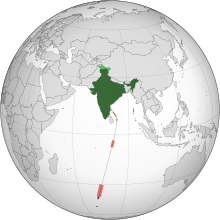
The Space Shuttle is a retired, partially reusable low Earth orbital spacecraft system operated from 1981 to 2011 by the U.S. National Aeronautics and Space Administration (NASA) as part of the Space Shuttle program. Its official program name was Space Transportation System (STS), taken from a 1969 plan for a system of reusable spacecraft where it was the only item funded for development.

A spacecraft is a vehicle that is designed to fly in outer space and operate there. Spacecraft are used for a variety of purposes, including communications, Earth observation, meteorology, navigation, space colonization, planetary exploration, and transportation of humans and cargo. All spacecraft except single-stage-to-orbit vehicles cannot get into space on their own, and require a launch vehicle.

The Polar Satellite Launch Vehicle (PSLV) is an expendable medium-lift launch vehicle designed and operated by the Indian Space Research Organisation (ISRO). It was developed to allow India to launch its Indian Remote Sensing (IRS) satellites into Sun-synchronous orbits, a service that was, until the advent of the PSLV in 1993, only commercially available from Russia. PSLV can also launch small size satellites into Geostationary Transfer Orbit (GTO).
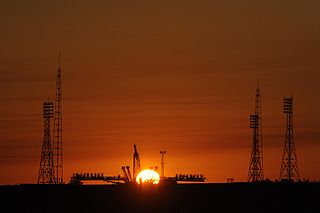
A spaceport or cosmodrome is a site for launching or receiving spacecraft, by analogy to a seaport for ships or an airport for aircraft. The word spaceport, and even more so cosmodrome, has traditionally been used for sites capable of launching spacecraft into orbit around Earth or on interplanetary trajectories. However, rocket launch sites for purely sub-orbital flights are sometimes called spaceports, as in recent years new and proposed sites for suborbital human flights have been frequently referred to or named "spaceports". Space stations and proposed future bases on the Moon are sometimes called spaceports, in particular if intended as a base for further journeys.

STS-41-C was NASA's eleventh Space Shuttle mission, and the fifth mission of Space Shuttle Challenger. The launch, which took place on April 6, 1984, marked the first direct ascent trajectory for a Space Shuttle mission. During the mission, Challenger's crew captured and repaired the malfunctioning Solar Maximum Mission satellite, and deployed the Long Duration Exposure Facility (LDEF) experimental apparatus. STS-41-C was extended one day due to problems capturing the Solar Max satellite, and the landing on April 13, 1984, took place at Edwards Air Force Base, instead of at Kennedy Space Center as had been planned. The flight was originally numbered STS-13.
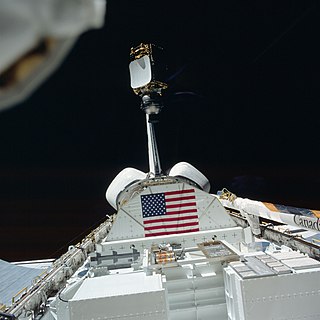
STS-8 was the eighth NASA Space Shuttle mission and the third flight of the Space Shuttle Challenger. It launched on August 30, 1983, and landed on September 5, 1983, conducting the first night launch and night landing of the Space Shuttle program. It also carried the first African-American astronaut, Guion Bluford. The mission successfully achieved all of its planned research objectives, but was marred by the subsequent discovery that a solid-fuel rocket booster had almost malfunctioned catastrophically during the launch.

STS-36 was a NASA Space Shuttle mission, during which Space Shuttle Atlantis carried a classified payload for the U.S. Department of Defense (DoD) into orbit. STS-36 was the 34th shuttle mission overall, the sixth flight for Atlantis, and the fourth night launch of the shuttle program. It launched from Kennedy Space Center, Florida, on February 28, 1990, and landed on March 4, 1990.

The Indian Space Research Organisation is the national space agency of India. It operates as the primary research and development arm of the Department of Space (DoS), which is directly overseen by the Prime Minister of India while the Chairman of ISRO also acts as the executive of DoS. ISRO is primarily responsible for performing tasks related to space-based operations, space exploration, international space cooperation and the development of related technologies. ISRO is one of the six government space agencies in the world that possesses full launch capabilities, can deploy cryogenic engines, can launch extraterrestrial missions and operate a large fleet of artificial satellites. ISRO is one of the four government space agencies to have soft landing (uncrewed) capabilities.

Satish Dhawan Space Centre – SDSC, is the primary spaceport of the Indian Space Research Organisation (ISRO), located in Sriharikota, Andhra Pradesh.

The Augmented Satellite Launch Vehicle or Advanced Satellite Launch Vehicle was a small-lift launch vehicle five-stage solid-fuel rocket developed by the Indian Space Research Organisation (ISRO) to place 150 kg satellites into LEO. This project was started by India during the early 1980s to develop technologies needed for a payload to be placed into a geostationary orbit. Its design was based on Satellite Launch Vehicle. ISRO did not have sufficient funds for both the Polar Satellite Launch Vehicle programme and the ASLV programme at the same time and the ASLV programme was terminated after the initial developmental flights. The payloads of ASLV were Stretched Rohini Satellites.

The Launch Vehicle Mark-3 or LVM3 is a three-stage medium-lift launch vehicle developed by the Indian Space Research Organisation (ISRO). Primarily designed to launch communication satellites into geostationary orbit, it is also due to launch crewed missions under the Indian Human Spaceflight Programme. LVM3 has a higher payload capacity than its predecessor, GSLV.
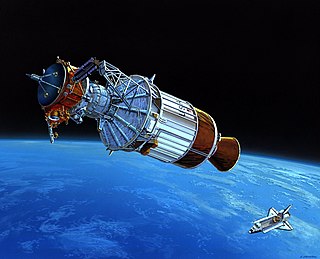
The Inertial Upper Stage (IUS), originally designated the Interim Upper Stage, was a two-stage, solid-fueled space launch system developed by Boeing for the United States Air Force beginning in 1976 for raising payloads from low Earth orbit to higher orbits or interplanetary trajectories following launch aboard a Titan 34D or Titan IV rocket as its upper stage, or from the payload bay of the Space Shuttle as a space tug.
A near-equatorial orbit is an orbit that lies close to the equatorial plane of the object orbited. Such an orbit has an inclination near 0°. On Earth, such orbits lie on the celestial equator, the great circle of the imaginary celestial sphere on the same plane as the equator of Earth. A geostationary orbit is a particular type of equatorial orbit, one which is geosynchronous. A satellite in a geostationary orbit appears stationary, always at the same point in the sky, to observers on the surface of the Earth.

The Athena I, known as the Lockheed Launch Vehicle (LLV) at the time of its first flight and Lockheed Martin Launch Vehicle (LMLV) at the time of its second flight, was an American small expendable launch system which was used for four launches between 1995 and 2001. It is a member of the Athena family of rockets, along with the larger Athena II.

A space tug is a type of spacecraft used to transfer spaceborne cargo from one orbit to another orbit with different energy characteristics. The term can include expendable upper stages or spacecraft that are not necessarily a part of their launch vehicle. However, it can also refer to a spacecraft that transports payload already in space to another location in outer space, such as in the Space Transportation System concept. An example would be moving a spacecraft from a low Earth orbit (LEO) to a higher-energy orbit like a geostationary transfer orbit, a lunar transfer, or an escape trajectory.

The Mars Orbiter Mission (MOM), unofficially known as Mangalyaan, was a space probe orbiting Mars since 24 September 2014. It was launched on 5 November 2013 by the Indian Space Research Organisation (ISRO). It was India's first interplanetary mission and it made ISRO the fourth space agency to achieve Mars orbit, after Roscosmos, NASA, and the European Space Agency. It made India the first Asian nation to reach the Martian orbit and the first nation in the world to do so on its maiden attempt.
PSLV-C34 was the 36th mission of the PSLV program and 14th mission of PSLV in XL configuration. The PSLV-C34 successfully carried and deployed 20 satellites in the Sun-synchronous orbit. With a launch mass of 320,000 kilograms (710,000 lb) and payload mass of 1,288 kilograms (2,840 lb), the C34 set a new record of deploying the maximum number of satellites by Indian Space Research Organisation in a single mission. The PSLV-C34 carried One Cartosat-2 satellite, SathyabamaSat, Swayam & 17 other satellites from United States, Canada, Germany & Indonesia.
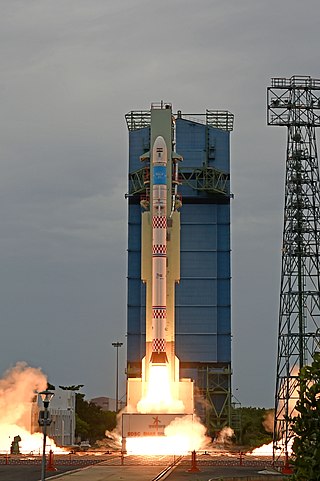
The Small Satellite Launch Vehicle (SSLV) is a small-lift launch vehicle developed by ISRO with payload capacity to deliver 500 kg (1,100 lb) to low Earth orbit or 300 kg (660 lb) to Sun-synchronous orbit for launching small satellites, with the capability to support multiple orbital drop-offs. SSLV is made keeping low cost, low turnaround time in mind with launch-on-demand flexibility under minimal infrastructure requirements.

Shuttle-Centaur was a version of the Centaur upper stage rocket designed to be carried aloft inside the Space Shuttle and used to launch satellites into high Earth orbits or probes into deep space. Two variants were developed: Centaur G-Prime, which was planned to launch the Galileo and Ulysses robotic probes to Jupiter, and Centaur G, a shortened version planned for use with United States Department of Defense Milstar satellites and the Magellan Venus probe. The powerful Centaur upper stage allowed for heavier deep space probes, and for them to reach Jupiter sooner, prolonging the operational life of the spacecraft. However, neither variant ever flew on a Shuttle. Support for the project came from the United States Air Force (USAF) and the National Reconnaissance Office, which asserted that its classified satellites required the power of Centaur. The USAF agreed to pay half the design and development costs of Centaur G, and the National Aeronautics and Space Administration (NASA) paid the other half.
Kulasekarapattinam Spaceport is the second spaceport of the Indian Space Research Organisation (ISRO), located in Kulasekarapattinam, a coastal village in Thoothukudi district of Tamil Nadu, India. The facility is being constructed over 2,350 acres. As of July 2022, the acquisition of land had been completed.
